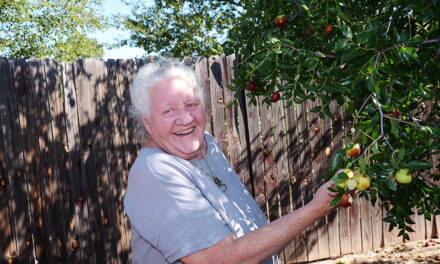At a time in life when many people would be contemplating a sedentary life, one Los Lunas septuagenarian is literally conquering mountains.
Shortly before celebrating his 80th birthday on Aug. 25, Fred Pomeroy was on top of the world with his three daughters — 19,350 feet up on the top of Africa’s tallest point, Mount Kilimanjaro.
So how did a man who calls Valencia County home, by way of a childhood in Alaska, end up 160 miles south of the equator at 79-years-old?
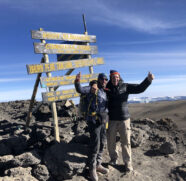
Celebrating what is technically the halfway point of a mountain climb — the summit — Fred Pomeroy, of Los Lunas, has made it to the top of two of the seven highest points in the world. His climb up Mount Kilimanjaro this summer was the second.
Photos courtesy of Fred Pomeroy
That story begins 22 years ago, on New Mexico’s tallest point, Wheeler Peak near Taos.
“My son, Mike, and I had climbed the peak and we were sitting around the campfire, and he said it would be interesting to climb each state’s highest point,” Pomeroy recalls.
They made it up Colorado’s Mountain Elbert, Texas’ Guadalupe Peak and Oklahoma’s Black Mesa, and got to 10,000 feet on Mount Reiner in Washington before high winds forced them off the mountain. He went back to Reiner in July 1990
Mike completed four, high points with his father before he was killed in a car accident on N.M. 60 in 1999.
“I decided to climb the rest of the U.S. high points in his honor,” Pomeroy said, a goal he completed in 2004, after climbing to the top of Granite Peak in Montana.
Pomeroy, a former Los Lunas Schools superintendent, climbed the highest point in the U.S. in 2001 when he climbed Mt. McKinley, 20,300 feet, as part of his 50 highest U.S. points climbs, since it’s the highest point in his home state of Alaska.
The 18-day technical climb, requiring ropes, scaling ice and crevasse crossings, was the biggest Pomeroy has done. He was 61 years old at the time.
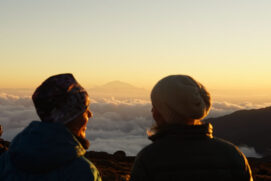
Two of Fred Pomeroy’s daughters, Sherry Petersen and Polly Everingham, take in the view from above the clouds on Mount Kilimanjaro, the highest peak in Africa.
During his climbs, Pomeroy has always carried a bit of his son with him.
“Mike was a water fowl hunter and he had this little duck,” he said. “So, he’s been up McKinley. He went on a six-week, coast-to-coast bike ride, and dipped his tail in the Pacific and his bill in the Atlantic. He’s been to the top of Mount Kilimanjaro.”
Kili, as climbers call it, is in northeast Tanzania, just south of the Kenyan border. The dormant volcano is the highest mountain in Africa at 19,350 feet.
There had been a lot of talk about climbing Kilimanjaro and the remaining six highest points in the world at family gatherings, Pomeroy said, but the commitment to Africa was made in 2018.
“I wanted to do this with the three girls, and last Christmas, it finally got to ‘Are we going to do this?’ Yeah,” he said.
Pomeroy and his three daughters — Sherry Petersen, Polly Everingham and Pam Burns — spent two weeks in Africa. They were on the mountain, climbing to the summit, for seven days and six nights, and spent three days on safari in Arusha, west of the Mount Kilimanjaro National Park.
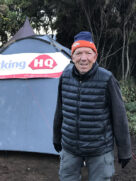
Fred Pomeroy, 80, spent seven days and six nights climbing Mount Kilimanjaro, the highest point on the continent of Africa with his three daughters in August.
The start of the climb in the rain forest called for shorts and T-shirts, Pomeroy said.
“We went through different climates,” he said. “Summit day, the wind was blowing and it was cold, but other than that, it was a beautiful day.”
While not a technical climb the likes of Mt. McKinley, there was still a great deal of gear to be packed in and out.
Sleeping tents, a mess tent with tables and chairs, food and cooking gear was lugged up the mountain by 19 porters for the four climbers.
Pomeroy and his daughters carried their own multiple changes of clothing and personal climbing gear.
To climb Kilimanjaro, a guide is required, so he found an Australian outfit called Climbing the Seven Summits, which seemed fitting for the trip. The company in turn had to hire three local guides from Tanzania for the climb.
As someone who’s always been active and done outdoor activities, Pomeroy upped his training to include bleacher climbs before summitting McKinley.
“And living at 5,000 feet also has its advantages,” he said with a laugh.
On one of the seven tallest peaks in the world, Mount Kilimanjaro in Africa, climbers bring everything, including shelter and lights.
When he was preparing to climb McKinley, Pomeroy was still working, so on weekends he would load up a backpack with 40 or 50 pounds and head up into the Sandia or Manzano mountains or go climbing near the Santa Fe ski area.
“I camped in the winter, in the cold, to get in the mindset,” he said.
Training for Kili was a similar routine with the added benefit of coming off the Senior Olympics in June, where he took medals in cycling and power walking.
“It was a good base. I was up to (biking) eight miles a day in preparing for Kilimanjaro, and did a lot of walking on Los Lunas Hill and hiked in Santa Fe to get elevation,” he said.
During his ascents, Pomeroy said he’s not been injured, although he can’t say the same for bicycling.
“I’ve been blessed with good health, but I had to work at it though,” he said.
Weather is the biggest unknown for any climb, Pomeroy said. It took two attempts to make the summit of Rainer and three for McKinley due to bad turns in the weather.
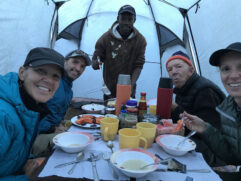
Porters carried necessary gear such as a meal tent, food and cooking gear up the mountain. Pictured here, Fred Pomeroy and two of his daughters, Pam Burns and Polly Everingham, enjoy breakfast with two of the guides for their trip up Mount Kilimanjaro.
“McKinley, it was always subzero,” he said. “When we finally made it to the summit, it was below zero and no wind.”
The weather was cooperative for the Kilimanjaro climb, rain free — even in the rain forest. The mountain, while high and containing glacier fields, was mostly an uphill climb through terrain similar to New Mexico’s high desert.
“The other thing on the bigger mountains is, ‘How will my body handle the altitude?’” Pomeroy said.
Climbers can fall prey to cerebral edema — a fluid build up around the brain — and it can be fatal, he said.
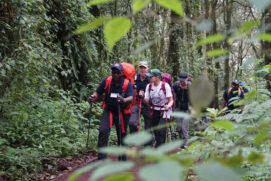
The climb up Mount Kilimanjaro, the highest point on the African continent, begins in the rain forest. Los Lunas resident Fred Pomeroy and his three daughters climbed the mountain this summer, carrying several changes of clothes necessary to get to the 19,350 foot summit.
The medication Diamox is often used to prevent and treat what is commonly called “altitude sickness,” but Pomeroy was able to make the Kili climb without it.
“You also have to be careful because you will lose your appetite on the higher mountains and have to force yourself to eat and drink,” he said. “A lot of times you’re melting snow for drinking water. It can be difficult to stay hydrated.”
Now having climbed the third and fourth highest peaks in the world, Pomeroy isn’t sure what comes next.
“Who knows,” he said with a chuckle.
Julia M. Dendinger began working at the VCNB in 2006. She covers Valencia County government, Belen Consolidated Schools and the village of Bosque Farms. She is a member of the Society of Professional Journalists Rio Grande chapter’s board of directors.




